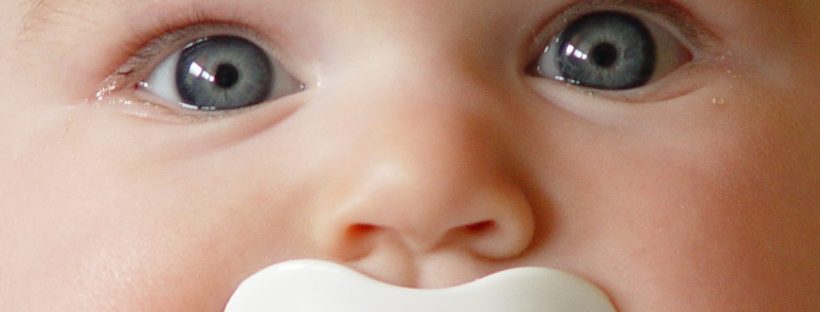In this article we go over the numerous changes in your baby’s vision, baby activities that will help activate key visual developments, and recommended toys and other items that match your baby’s visual abilities.
What does a young baby see? Baby’s Vision from 2-5 Months:
Prior to 2 months old, your baby’s vision was limited in distance, color, and dimension (Read more on newborn’s vision). Within the next 3 months, her vision will develop and change dramatically. The sensory development of sight opens the door for babies to engage, experience, and learn about the amazing new world around them and therefore is a key player in their emerging minds.
During these few months, the coordination between both of her eyes will improve, pairing nicely with the fine motor milestones of pre-reaching and reaching. This also allows her to target moving objects much better. In fact, your baby will look slightly before where the object is moving versus following it’s motion exactly. She is deciding where to look! This marks a major cognitive milestone, which occurs between 4-6 months of age.
Around 2-5 months old, your infant’s vision will change rapidly, within weeks, from 2D vision to 3D vision, with the average age of this transition beginning around 3.5 months. She will also be able to see gradients of brightness and shades of colors easier, and around 3 months she will now be able to see blues and yellows much clearer. By 4 months of age, your little one should be able to see the full range of colors and shades. Also beginning around 4 months, your baby’s visual development achieves the big milestone of improved visual acuity. This means that she will be able to see much more detail in the things around her- her recent blurry vision almost obsolete! Baby’s distance vision will also improve more and more over these months to the point that she will be able to see across the room.
Another big developmental stage your baby will go through is called obligatory looking, which can occur as early as 1 month and usually ends around 4 months. This is the stage where your infant will stare or seem fixated on something for a long period of time, and seems to be important in wiring your baby’s visual areas of her brain. Sometimes, it’s a good idea to help her break that fixation as it may be slightly distressing to them if they are viewing a strong visual stimuli that they cannot look away from. In some studies, this was found to be high contrast checkerboard patterns. Many parents enjoy this infant stage because this is when many parents bond with their babies- during prolonged, interactive eye contact.
A note about eye crossing: The brain needs normal visual input for it to wire correctly. If your infant’s coordination of her two eyes is impaired, as in the case of crossed-eyes, and allowed to continue without intervention, her vision may be irreversibly jeopardized. Ask your pediatrician if you are concerned about your baby’s vision.
Activities to engage an infant’s visual development:
Obligatory looking is a milestone your baby will reach during these months. Engage her with 1 on 1 conversation! Not only does she still prefer human faces best, but this baby activity also provides language development. Practice taking turns “talking”- meaning add pauses as you would in normal conversation. Also, make different, fun, and light hearted faces during this baby game.
Hang toys so that they are within their reach. Make sure toys are enticing and vary in color, shape, and texture (see below recommendations) as they begin to focus more and more on what they look at. Also, change out the toys you have every couple of weeks. As always, make sure you are with your baby and exercise safety to ensure there is no risk of entanglement in cords or wires.
Ensure your baby has baby play time on their tummy. This gives them a different vantage point in their view while also developing their muscles for gross motor skills. Toys with mirrors are great toys to capture infant’s attention and can prolong infant play time.
If your baby frequently lays in their crib or playpen, be sure to move where the crib or playpen is. For instance, instead of doing baby activities in her room, move the playpen into the living room! You can also change the end of the bed you lay her head. This lets your baby see different things. Remember, visual experience is important when the brain is wiring areas of their brain for vision.
Another fun game to play with baby is the classic peek-a-boo. Also be sure to incorporate brightly colored books in your things to do with baby list. As you read, point to things to let her practice following where you point as well as listening to what you are speaking about. We list some favorite books we like below.
Be sure to check out more sensory activities for infants on the Activity Page as you will find more and specific baby activities.
Recommended Baby Toys:
As you have read above, your baby’s eye sight is progressing rapidly, and she’s going to start to look for things that are more stimulating for her to see. For instance, at 3 months, infants begin to like circular patters more. We also have learned that her eyes are now working together and she is also beginning to work on coordinating her sight and body to reach and grab toys. Baby’s ability to see colors, shades of colors, and details takes a drastic leap forward. Below we list toys we recommend for your baby that stimulates their vision and also entices them to practice their fine motor skill development.
